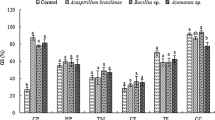Abstract
The aim of our work is to investigate the changes in phenolic level, PAL activity and heat production rate induced during pre-hardening at 12°C and cold acclimation at 2°C of the forage grasses Festulolium, meadow fescue, tall fescue and Italian ryegrass in relation to their resistance to snow mould caused by Microdochium nivale. Meadow fescue and tall fescue were most resistant to M. nivale infection, while Italian ryegrass demonstrated the least resistance to this fungus inoculation. Festulolium, meadow fescue and tall fescue responded similarly to low temperature, while Italian ryegrass demonstrated considerable disturbance of energy balance and lower phenolic concentration, which could explain a higher susceptibility of the latter species to infection by M. nivale. The enhanced level of phenolic compounds, probably utilised for cell wall lignification as well as equilibrium of the metabolic activity observed in meadow fescue and tall fescue, is very important for both cold and pathogen-resistance mechanisms. The studied Festulolium cultivar ‘Felopa’, a hybrid of the Lolium multiflorum and Festuca pratensis genomes, was characterised by changes in biochemical parameters similar to the resistant meadow fescue and tall fescue.






Similar content being viewed by others
Abbreviations
- ASI:
-
Average Severity Index
- DW:
-
Dry weight
- FW:
-
Fresh weight
- MEC:
-
Metabolic efficiency coefficient
- PAL:
-
Phenylalanine ammonia-lyase
- PPFD:
-
Photosynthetic photon flux density (μmol m−2 s−1)
- TAL:
-
Tyrosine ammonia-lyase
References
Anekonda TS, Criddle RS, Libby WJ, Breidenbach RW, Hansen LD (1994) Respiration rates predict differences in growth of coast redwood. Plant Cell Environ 17:1793–1798
Bowler C, Fluhr R (2000) The role of calcium and activated oxygens as signals for controlling cross-tolerance. Trends Plant Sci 5:241–246
Bradford M (1976) A rapid and sensitive method for the quantitation of microgram quantities of protein utilizing the principle of protein-dye binding. Anal Biochem 72:248–254
Christie PJ, Alfenito MR, Walbot V (1994) Impact of low temperature stress on general phenylpropanoid and anthocyanin pathways: Enhancement of transcript abundance and anthocyanin pigmentation in maize seedlings. Planta 194:541–549
Criddle RS, Breidenbach RW, Rank DR, Hopkin MS, Hansen LD (1990) Simultaneous calorimetric and respirometric measurements on plant tissues. Thermochimica Acta 172:213–221
Criddle RS, Fontana AJ, Rank DR, Paige D, Hansen LD, Breidenbach RW (1991) Simultaneous measurement of metabolic heat rate, CO2 production, and O2 consumption by microcalorimetry. Anal Biochem 194:413–417
Dixon RA, Paiva NL (1995) Stress-induced phenylpropanoid metabolism. Plant Cell 7:1085–1097
Gaudet DA, Laroche A, Yoshida M (1999) Low temperature-wheat-fungal interaction: a carbohydrate connection. Physiol Plant 106:437–444
Gaudet DA, Laroche A, Trick M, Huel R, Puchalski B (2003) Cold induced expression of plant defensin and lipid transfer protein transcripts in winter wheat. Physiol Plant 117:195–205
Hahlbrock K, Scheel D (1989) Physiology and molecular biology of phenylpropanoid metabolism. Annu Rev Plant Physiol Plant Mol Biol 40:347–369
Hartman CL, McCoy TJ, Knous TR (1984) Selection of alfalfa (Medicago sativa) cell lines and regeneration of plant resistant to the toxin(s) produced by Fusarium oxysporum f.sp. medicaginis. Plant Sci Lett 34:183–194
Itai C, Richmond A, Vaadia Y (1968) The role of root cytokinine during water and salinity stress. Israel J Bot 17:187–195
Kang Z, Huang L, Buchenauer H (2004) Ultrastructural and cytochemical studies on infection of wheat spikes by Microdochium nivale. J Plant Dis Prot 111:351–361
Kefu Z, Munns R, King RW (1991) Abscisic acid levels in NaCl-treated barley, cotton and salt-bush. Austr J Plant Physiol 18:17–24
Laroche A, Gaudet DA, Audy P, Frick MM, Mullin J (1997) Induction of freezing tolerance and snow mould resistance in winter wheat: biochemical and molecular perspectives. In: Proceedings of the international symposium on cereal adaptation to low temperature stress, Martonvásár, Hungary, June 2–4, 1997
Peltonen S, Karjalainen R (1995) Phenylalanine ammonia-lyase activity in barley after infection with Bipolaris sorokiniana or treatment with purified xylanase. J Phytopathol 143:239–245
Płażek A, Żur I (2003) Cold-induced plant resistance to necrotrophic pathogens and antioxidant enzyme activities and cell membrane permeability. Plant Sci 164:1019–1028
Prończuk M, Prończuk S (1987) Przydatność “metody chłodniowej” w ocenie odporności życicy trwałej na Fusarium nivale (Fr) Ces. Biuletyn IHAR 162:27–32
Sanchez-Ballesta M, Lafuente MT, Zacarias L, Granell A (2000) Involvement of phenylalanine ammonia-lyase in the response of Fortune mandarin fruits to cold temperature. Physiol Plant 108:382–389
Singleton VS, Rossi JA Jr (1965) Colorimetry of total phenolics with phosphomolybdic-phosphotungstic acid reagent. Am J Enol Viticult 16:144–157
Solecka D, Kacperska A (1993) Activity of l-phenylalanine ammonia-lyase in winter rape leaves treated with cold. Acta Biochim Pol 40:113–115
Streuter N, Moerschbacher BM, Fischer Y, Noll U, Reisener HJ (1989) Fructose-2,6-bisphosphate in wheat leaves infected with steam rust. J Plant Physiol 134:254–257
Tronsmo AM (1984) Resistance to the rust fungus Puccinia poae-nemoralis in Poa pratensis induced by low-temperature hardening. Can J Bot 62:2891–2892
Tronsmo AM (1985) Effects of dehardening on resistance to freezing and to infection by Typhula ishicariensis in Phleum Pratense. Acta Agric Scand 35:113–116
Tronsmo AM (1986) Host water potentials may restrict development of snow mould fungi in low temperature-hardened grasses. Physiol Plant 68:175–179
Wiśniewski K, Zagdańska B, Prończuk M (1997) Interrelationship between frost tolerance, drought and resistance to snow mould (Microdochium nivale). (W:). In: Proceedings of the international symposium on cereal adaptation to low temperature stress. Agricultural Research Institute of the Hungarian Academy of Sciences, Martonvásár, Hungary, pp 221–226
Author information
Authors and Affiliations
Corresponding author
Additional information
Communicated by B. Barna.
Rights and permissions
About this article
Cite this article
Pociecha, E., Płażek, A. Cold acclimation of forage grasses in relation to pink snow mould (Microdochium nivale) resistance. Acta Physiol Plant 32, 37–43 (2010). https://doi.org/10.1007/s11738-009-0373-5
Received:
Revised:
Accepted:
Published:
Issue Date:
DOI: https://doi.org/10.1007/s11738-009-0373-5




